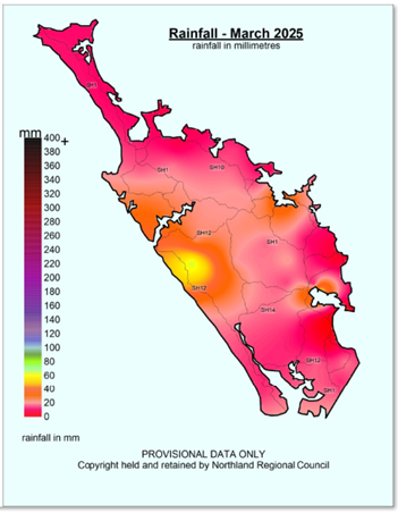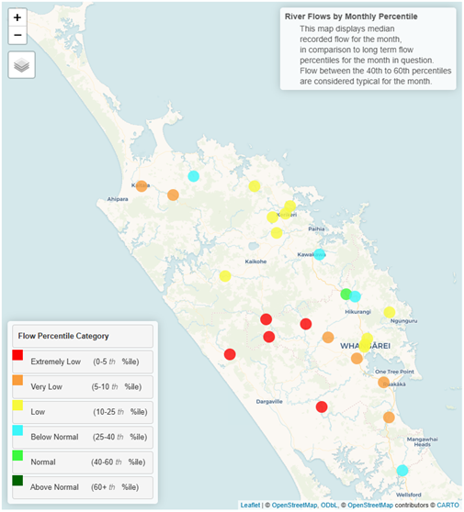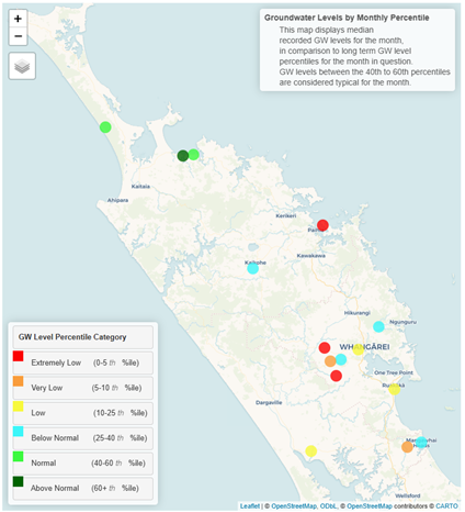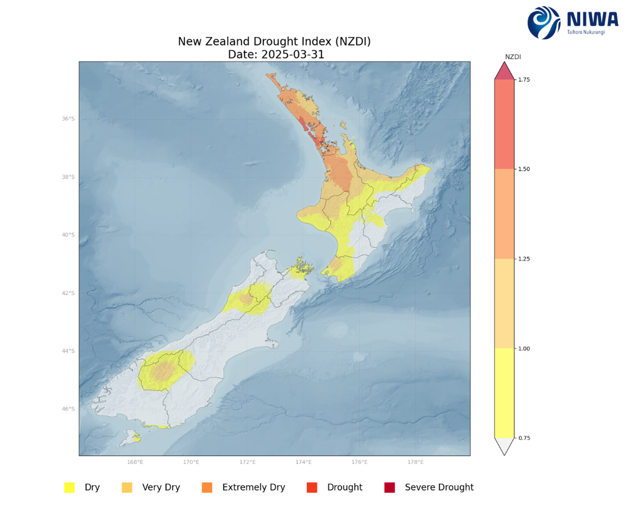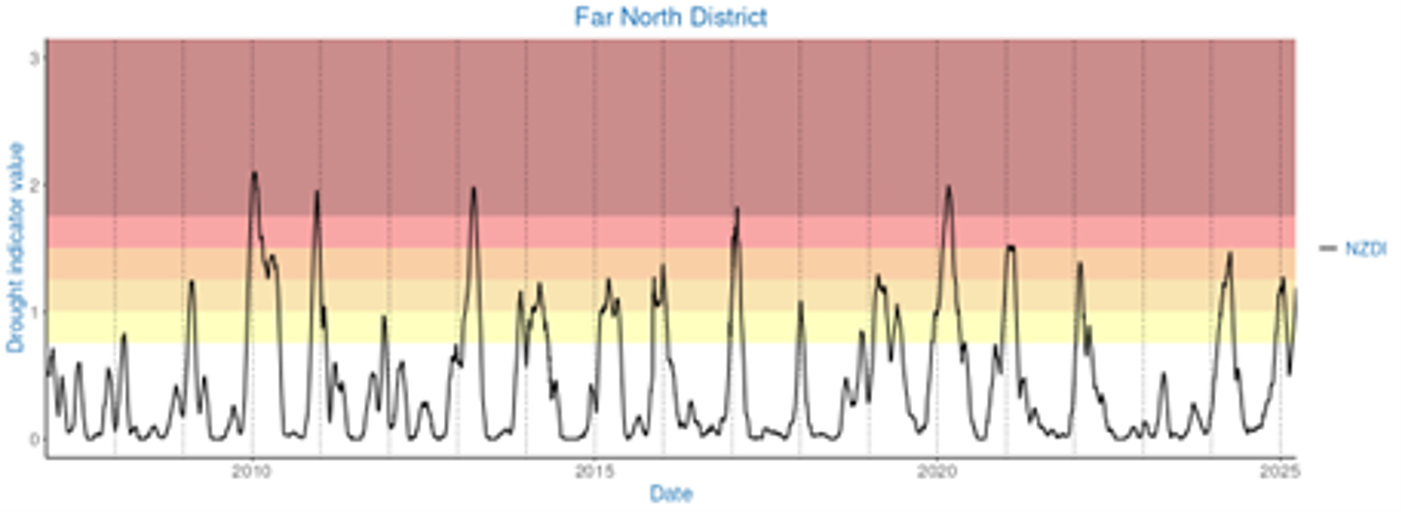March 2025 climate report
8 Apr 2025, 3:00 PM
Key take away from this report
March was another month of very low rainfall for Northland. Conditions across the region range from near normal for this time of year in some parts of the north and east, to drought conditions in central and western areas, particularly the southwest. Some relief may be on the way soon as MetService issued a Heavy Rain Watch for Northland on 2 April.
Summary
- Northland region as a whole averaged 22% of the expected rainfall for March.
- Large areas of central and western Northland are severely dry for this time of year, particularly in the southwest around the Kaihu catchment, Kai Iwi lakes, Dargaville, and Te Kopuru.
- River flows in central and western catchments were “Extremely Low” for March. River flows in other parts of the region ranged from “Below Normal” to “Very Low”.
- Groundwater levels range from “Normal” to “Above Normal” in the Far North, and “Low” to “Extremely Low” through the rest of the region.
- Soil moisture levels are well below average across the region. Southwestern areas are particularly low with a sustained soil water deficit.
- Temperatures are most likely to be above average (55% chance) over the next three months.
- Rainfall totals are most likely to be near normal (45% chance) over the next three months. Heavy rain events are possible on occasion.
- Soil moisture levels are most likely (50% chance) to be below normal over the next three months.
- River flows are most likely (50%) to be below normal over the next three months.
- MetService issued a Heavy Rain Watch for Northland on Wednesday 2 April, and this system has potential to bring some welcome rainfall to the region.
- There is a risk that, if extended periods of low rainfall continue, parts of Northland, particularly in central and western areas, could experience an increasing level of meteorological, hydrological, and agricultural drought (with lower river flows, groundwater levels, water reservoirs, and soil moisture etc.,) over the next three months.
- On average at least one ex-tropical cyclone (TC) passes within 550km of New Zealand (NZ) each year. This season the risk is considered normal to elevated through April.
Rainfall
Northland region averaged 20mm of rainfall, 22% of the long-term median (normal expected) for March. The highest rainfall totals for the month were recorded at Waimamaku with 65mm, Whangārei.
Airport with 59.8mm, and Tutamoe with 53.5mm. The highest percentage of normal expected rainfall was recorded at Tutamoe with 64%, and Ōpua with 49%. The lowest rainfall totals for the month were at Wilsons Dam in Bream Bay with 2mm, and Marsden Point with 3mm, both with 3% of the normal expected rainfall for March.
Figures 1 and 2: March rainfall distribution for Northland in mm, and in percentage of median. Showing an average of 20 mm (22% of expected) rainfall for the region.
The standardised rainfall index (SPI) is useful to compare the rainfall in Northland as a whole, as the site-specific patterns are removed from the data. On a three-month scale between January – March (Figure 3) the SPI indicates “Near Normal” to ‘Moderately Dry’ conditions. On a six-month scale from October – March (Figure 4) the SPI indicates that some areas of Northland are “Severely Dry”. On a 12-month scale the SPI indicates that large areas of Northland are “Severely Dry” and some areas are “Extremely Dry”. The SPI helps understand the reserves in soil moisture, and river flow, and how quickly catchments will drain. The extended dry means that the region is likely to drain quicker than expected following rain events.
Figures 3, 4 and 5: Standardised rainfall for Northland on a 3-month scale (January – March), a 6-month scale (October– March), and a 12-month scale (April to March).
River Flows
River flows in central and western catchments were “Extremely Low” for March. River flows in other parts of the region ranged from “Below Normal” to “Very Low”.
Figure 6: River flows in Northland for March 2025.
Groundwater
Groundwater levels in Northlands key monitored aquifers in March range from “Extremely Low” to “Above Normal”. This regional variation is primarily due to differences in rainfall distribution and aquifer geology.
Figure 7: Groundwater levels in Northland’s primary monitored aquifers for March.
Soil moisture
Soil Moisture remains low throughout Northland (Figure 8). All sites are well below 75 mm of deficit at the start of April. This is below the temporary wilting point for most plants, and there is likely to be little new/ continued growth. Many areas, particularly the southwest, have been in long term, significant deficit, and plant distress is likely to be occurring (browning of pasture, slow or no plant growth, wilting etc). The soil moisture deficit is calculated based on incoming daily rainfall (mm), outgoing daily potential evapotranspiration (mm), and a fixed available water capacity (the amount of water in the soil 'reservoir' that plants can use) of 150 mm”.
Figure 8: Calculated daily soil moisture values at key areas around Northland, courtesy of NIWA.
Note: Some graphs below do not have all March data available.
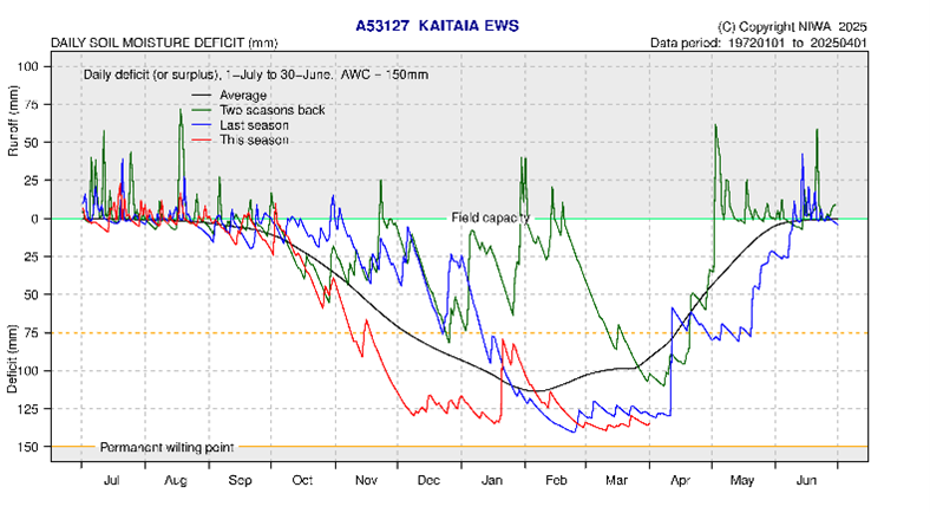 Figure 8: Kaikohe calculated daily soil moisture values - March 2025
Figure 8: Kaikohe calculated daily soil moisture values - March 2025
 Figure 8: Kerikeri calculated daily soil moisture values - March 2025
Figure 8: Kerikeri calculated daily soil moisture values - March 2025
 Figure 8: Dargaville calculated daily soil moisture values - March 2025
Figure 8: Dargaville calculated daily soil moisture values - March 2025
 Figure 8: Whangārei calculated daily soil moisture values - March 2025
Figure 8: Whangārei calculated daily soil moisture values - March 2025
 Figure 8: Warkworth calculated daily soil moisture values - March 2025
Figure 8: Warkworth calculated daily soil moisture values - March 2025

Climate Outlook for April – June 2025
Summary of climate forecasts from NIWA and MetService
The oceanic markers of La Niña have weakened, and most are now within the neutral ENSO range, though the atmosphere still exhibits signals consistent with La Niña conditions. The threat of heavy rainfall events will be elevated when tropical or sub-tropical air flows occur, as expected in early April. Late April is showing signs of unsettled weather for most of NZ and increased chances of rainfall.
For more information visit the following links:
Table 1: Forecasted likelihood of above, near or below average climate conditions for Northland from March – May 2025.
(Expressed as % likelihood).
| Temperature | Rainfall | Soil moisture | River flows | |
| Above average | 55• | 35 | 5 | 10 |
| Near average | 35 | 45• | 45 | 40 |
| Below average | 10 | 20 | 50• | 50• |
NIWA Drought Index
The NIWA Drought Index (NZDI) on 31 March 2025 (Figure 9) indicates “Drought” in the southwest of Northland from the Kaihu catchment north of Dargaville down to Poutō Point. The index indicates “Extremely Dry” conditions for most of the rest of Northland, to “Very Dry” conditions in the mid-east. The index is based on the Standardised Precipitation Index, the Soil Moisture Deficit, the Soil Moisture Deficit Anomaly, and the Potential Evapotranspiration Deficit, with a value less than 0.75 considered normal – wet.
Figure 9: NIWA New Zealand Drought Index produced 31 March 2025
Figure 10: NIWA drought index tracking for the Far North, Whangārei and Kaipara districts from 2018 – 2025 produced 27 March 2025
Northland Drought Risk Assessment
The drought risk assessment (Table 2) provides a visual summary of the current conditions of Northlands rainfall, river flows, and groundwater levels and the current state of water resources. It also incorporates NIWA’s Climate Outlook and Drought Index, and MetService Forecasts.
The Northland region averaged 22% of the normal expected rainfall for March.
River flows in central and western catchments were “Extremely Low” for March. River flows in other parts of the region ranged from “Below Normal” to “Very Low”. Some river flows, primarily in central and western catchments, are well below the residual minimum flow requirements for various consented water takes, including some district water supplies.
Groundwater levels range from “Normal” to “Above Normal” in the Far North, and “Low” to “Extremely Low” through the rest of the region.
Soil moisture levels are well below average across the region. Southwestern areas are particularly low with a sustained soil water deficit.
NIWA and MetService climate outlooks for the next three months predict that rainfall will most likely be near average, with river flows and soil moisture most likely to be below average.
Overall conditions in Northland are highly variable, and there is a general gradient from the northeast where some areas are experiencing close to normal conditions for this time of year, to central and western areas where drought conditions generally prevail, particularly in the southwest around the Kaihu catchment, Kai Iwi Lakes, Dargaville and Te Kopuru. This variation is reflected in the various maps for rainfall, river flows and groundwater levels, and in the table below.
MetService issued a Heavy Rain Watch for Northland on Wednesday 2 April, and this system has potential to bring some welcome rainfall to the region.
There is a risk that, if extended periods of low rainfall continue, parts of Northland, particularly in central and western areas, could experience an increasing level of meteorological, hydrological, and agricultural drought (with lower river flows, groundwater levels, water reservoirs, and soil moisture etc.,) over the next three months.
Table 2: Drought Risk assessment matrix.
| Current conditions | Extreme | Very low | Low | Normal | High | Very high | Extreme |
| Rainfall | |||||||
| SPI maps | |||||||
| River flows | |||||||
| Groundwater levels | |||||||
| Soil moisture | |||||||
| Water resources current state | |||||||
| NIWA 3-month outlook | |||||||
| NIWA drought index | |||||||
| MetService December forecast |
Tropical Cyclone Outlook
Summary of NIWA and MetService Outlooks
Late summer through early autumn is considered to be the peak of the tropical cyclone season.
On average at least one ex-tropical cyclone (TC) passes within 550km of New Zealand (NZ) each year (Figure 11). This season the risk is considered normal to elevated through April.
If an ex-TC tracks close to NZ, there is a near equal probability of it tracking to the east or west of the North Island. An ex-TC entering the NZ region could produce significant rainfall, severe winds, hazardous marine conditions and coastal damage.
Figure 11: Number of predicted named tropical cyclones interacting with an island group for the 2024-25 season.

